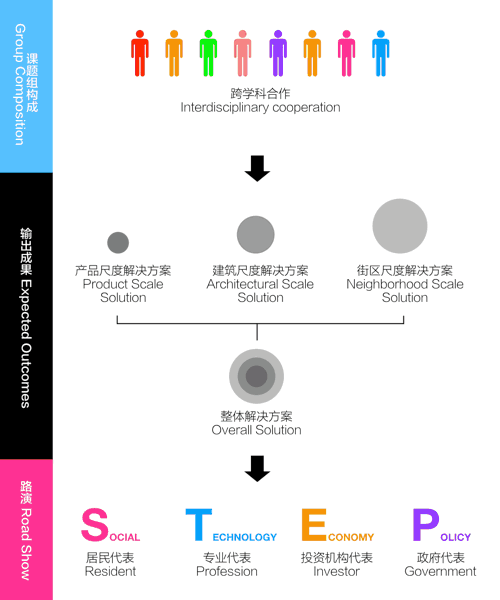日前,由同济大学设计创意学院、同济大学艺术与传媒学院、同济大学建筑设计研究院(集团)有限公司联合主办,由杨浦区新江湾城街道作为指导单位的2019同济大学国际联合设计工作营在同济大学设计创意学院暗房报告厅火热开营!
8月13日上午,2019同济大学国际联合设计工作营在同济大学设计创意学院暗房报告厅正式开营。本次工作营以“跨界 | 设计驱动的未来社区创新:设计 x 技术 x 运营”为主题,为期约两周,同济大学设计创意学院终身学习中心承办,同济大学-麻省理工学院上海城市科学实验室等实验室技术支持的高规格国际联合设计工作营,为国内外设计等相关专业背景学生及设计爱好者提供高质量的学习交流及实践机会,培养未来设计师。

此次工作营共将举办8场行业实例大咖讲座,15场课题工作坊和5余场参观考察。学员将通过此次创意营致力于探索新时代中国语境下科技、人文、空间、传媒、社会等综合议题的创造性整体解决方案,打通线上教学与线下实践的关键节点,最终以项目路演的方式完成从创意到落地的全过程体验,用“设计 x 技术 x 运营”的组合力量助力未来社区新的发展。
同济大学艺术与传媒学院副院长王建民、(同济大学)上海国际设计创新研究院常务副院长苏运升、上海合旅建筑规划设计有限公司总经理季正嵘、上海合旅建筑规划设计有限公司副总经理阎凯、爱回收产品设计总监、爱回收联合创始人江文华、爱回收分类回收事业部商务总监李玉晨、衡芯(上海)智库平台创始合伙人马磊等嘉宾领导及本期74余名学员出席了本次开幕活动。
王建民从专业的角度介绍了此次工作营的重要性,他认为社区是城市的交换站、服务大众很重要,希望各位学员在此次交叉学科的工作营中感受同济文化,未来的12天内取得可观的收获。
(同济大学)上海国际设计创新研究院常务副院长 苏运升
苏运升以“城市摩尔定律”为出发点,对“未来社区”这一概念进行解释,同时发布了本次工作营的主题以及课题。
本次工作营特别发布七大课题小组(跨学科组合),分别是“循环/零碳社区”、“社区新零售”、“都市农场”、 “未来社区交通”、 “未来都市娱乐”、 “新民宿” 、“未来社区景观”。旨在通过设计驱动以及多学科合作的方式,对社区的空间构成、新技术应用以及交互、服务与商业模式体系进行重新思考,以探索未来的生活方式的基本单元——未来社区。
本次工作营协同上海、湖南、海南三地、11所高校全程联动,邀请众多产业、学界的领军大咖担任演讲嘉宾、课题导师和专家评委,与学员们进行零距离跨界创新研讨。
下午,在同济大学设计创意学院设计坪坊中,学员们以棉花糖和干意面为原料,进行了破冰小挑战,最后评选出了高度最高和承重最好的两个小组作品,并颁予奖品。
8月14日,学员们进行了外出参访,分别对NICE2035、新江湾城街道垃圾分类情况、愚园百货、愚园公共市集及创邑Space等地进行了参观学习。
在烈日炎炎的一天,我们参观了多个地方,收获颇丰。首先是NICE2035,敞篷车顶做的帆布包让人眼前一亮,然后是新江湾城街道的垃圾分类投放设施,作为最早试点垃圾分类的小区,它的垃圾分类设施十分便民实用,接着愚园路,从前的老旧街区已经焕然一新,崭新的店铺与展览馆等让居民们的生活更加丰富多彩,生活在这样的社区想必是很幸福的,我们也应当勇于创新,让人们的幸福指数更高!
对旧街区的改造保留了原有的社区生活状态,并赋予了社区新的面貌和功能,让生活艺术化,让艺术生活化。柴米油盐诗和远方并非不可共存。随着城市现代化建设的进一步发展,旧城的保护和改造非常重要,愚园路的改造能带给我们很多启发。
愚园公共集市是一个比较现代化的社区建筑,装修年轻化,且有一些策展,配备了超市和小吃,满足一定程度的生活需求。装修和展览应该能吸引一批年轻人的关注。不过愚园社区的居民还是以上海原住民居多,很多都是老一辈的人,加上一些学区房和外国居民,这样的社区文化能否让这里的原住民满意还不太确定。个人觉得集市的想法虽然很好,如果再加上一些愚园自身的特点或上海老城区特色可能会更受到当地居民的欢迎。
今天参观的愚园百货、愚园社区公共集市、社区艺廊以及非常有想法的故事商店,这些具有开创性的实体空间将愚园路社区打造成一个与时俱进、充满惊喜的地方。最终站创邑SPACE则是这些实体空间的本质来源,通过创业者的交流想法,再一步步将其实体化落地成现在看到的具体空间场景。这样一种通过众创空间的起始点发散到周边社区的发展模式,我认为是在很多发展停滞或气氛沉闷的社区可以复制借鉴的。
社区是最贴近人们所需求的生活场所,通过植入互联网模式的垃圾分类创新实践是具有普世价值的。垃圾分类从社区出发,从社区进阶城市,从个人参与到全民参与,是一段长久的过程,社区环境值得我们共同爱护。
今天参观了愚园街道和垃圾分类示范点。愚园的思路是把商业地产按照类别层级分拆,平铺在愚园路上。和集成式地产思路的不同是,这样平铺式的结构可以避免破坏掉愚园路的古朴气息,让整条街道的各个地点都布满了文艺气息。垃圾分类点则更具有科技感,配合摄像头和分类识别技术,实现了分类的智能管控。
这次参观学到的一个思路是,城市的进步并非一定要推倒重来,改造和完善,让城市在继承中发展,更不失为一种好的思路。
今天了解到上海市新江湾城社区垃圾回收分类的实例,感触颇深,垃圾分类并不似常人想象中那么简单,需要考虑社区家庭结构差异、管道分布以及人员的配置部署等等不同的因素,大规模的推广还需要一定的时间和规划。
另外,从设计的两个角度来看,首先服务设计在其中的流程优化中还有大可作为的地方,其次从工业设计来讲,垃圾分类工厂集装箱似的外观气质,以及人机交互譬如按钮的尺寸情感反馈的方面还有许多可优化的空间。
湖南分场14日行程:
上午,导师以游戏设计启发灵感
下午,参观长沙博物馆、“霍金与乔治的宇宙”展
晚上,方案推进
未完待续
【同济大学设计创意学院】
同济大学设计创意学院是国内最具国际声誉的设计学院之一,跻身世界著名设计学院行列。2019年QS(Quacquarelli Symonds)世界大学学科排名中,学院在“艺术与设计(Artand Design)”学科位列全球第14名,亚洲排名第一。
2017年9月,教育部、财政部、国家发展改革委印发《关于公布世界一流大学和一流学科建设高校及建设学科名单的通知》,公布世界一流大学和一流学科(简称“双一流”)建设高校及建设学科名单,学院设计学科(Art & Design)入选世界一流学科建设。
学院是CUMULUS全球设计、艺术与媒体院校联盟成员,ICSID国际工业设计协会成员,DESIS社会创新和可持续设计联盟成员。2007-2010年间同济大学艺术设计系和同济大学设计创意学院连续3次被美国《商业周刊》评选为全球最佳设计学院及课程之一。2010年同济大学设计创意学院被PSDTUTS+网站评为全球最佳的18所设计学院之一。2011年“同济-阿尔托设计工厂”被著名的Monocle杂志评选为全球5大高校创新平台之一。2013年,设计创意学院入选国际著名设计杂志《FRAME》“全球设计硕士教育30佳”(World Leading Master Programs)。
同济大学设计创意学院主编的设计杂志《大设计》,在设计界具有较大影响。2013年起,同济大学设计创意学院与荷兰ELSEVIER出版社合作出版全英文设计研究学报“Design, Economics and Innovation”, 已于2015年春出版首期。
College of Design and Innovation (D&I), Tongji University, was developed from the Art and Design Department of the College of Architecture and Urban Planning, Tongji University. College of Design and Innovation, Tongji University(D&I) was ranked 14th in Art and Design according to Quacquarelli Symonds(QS) world university ranking by subject in 2019.
College of Design and Innovation, Tongji University, enjoys membership in CUMULUS, the International Association of Universities and Colleges of Art, Design and Media, ICSID, the International Council of Societies of Industrial Design, and DESIS, Design for Social Innovation & Sustainability. From 2007 to 2010, the Department of Art and Design and the College of Design and Innovation, Tongji University, were selected for three consecutive times as one of the world’s best colleges of design and courses. In 2010, College of Design and Innovation, Tongji University, was named one of the world’s best 18 colleges of design by PSDTUTS+ website. In 2011, “Tongji – Alto Design Factory” was selected as one of the five major global university innovation platforms by the famous magazine Monocle. In 2013, College of Design and Innovation was selected by the internationally renowned design magazine FRAME into the “Top 30 World Leading Master Programs”.
The design magazine, All Design, is edited by College of Design and Innovation, Tongji University, and has a great influence in the design community. Since 2013, College of Design and Innovation, Tongji University has cooperated with Holland Elsevier Publisher to publish an English journal of design research, Design Economics and Innovation. The first issue will be published in the spring in 2015.
【同济大学建筑设计研究院(集团)有限公司】
同济大学建筑设计研究院(集团)有限公司(TJAD)前身是成立于1958年的同济大学建筑设计研究院,是全国知名的大型设计咨询集团。依托百年学府同济大学的深厚底蕴,经过半个多世纪的积累和进取,TJAD拥有了深厚的工程设计实力和强大的技术咨询能力。在全国各地、非洲、南美有近万个工程案例。
Tongji Architectural Design(Group)Co.,Ltd.(TJAD),formerly known as the Architectural Design and Tesearch Institute of Tongji University,was founded in 1985 and has now developed into a well-known large-scale design consulting group.With one hundred years' history and the profound cultural foundation of Tongji University,TJAD has accumulated rich experience in both engineering design and technical consultancy through continuous progress in the course of half a century.
【同济大学艺术与传媒学院】
同济大学艺术与传媒学院聚焦于全媒体和表演艺术,致力于培养具有新理念、新视野、新技能的艺术与传媒领域专业精英和社会栋梁。学院的发展战略为:以新闻传播学为核心,以“全媒体”为特色,整合全院专业学科;聚焦主流传播、城市传播、智能传播三大前沿方向;力求融合突破、创新发展。
Focusing on “Omni-media”and “Performance art”, College of Arts andMedia, Tongji University devotes to cultivating students with new ideology, new view, new technologyin their professional arts and media field.
With the aim of creative development and rising,the strategy of the College is: to take journalism and communication as itscore and omni-media as its characteristics, Integrating the ProfessionalDisciplines of the College;to focus on Three Frontier Directions: PoliticalCommunication, Urban Communication and Intelligent Communication.
【同济大学设计创意学院终身学习中心】
同济大学设计创意学院终身学习中心是由同济大学设计创意学院发起的——致力于培养“立体T型”创新人才,以设计思维驱动跨文化、跨学科创新,助力个体认知持续性更新的全球设计教育终身实践平台。
中心提倡“以设计思考人类未来发展”。从寻求自我认同,到担当全球责任,是中国设计未来发展的使命。在全球知识网络时代,跨文化、跨学科的交流、学习、借鉴和协作,是一项长期且重要的主题设计。这从某种程度上来看是“经世致用”之学,其发展与政治、科技、社会、经济、文化环境紧密相关。
中心推动以“设计思维”整合科技、创意、商业模式,创造和引领未来需求,并通过满足和创造需求倒逼技术应用、技术转化和技术发明,进而推动创新创业,催生新业态、新经济和新模式。
中心认为“哪里有问题,哪里就需要设计”。但凡人们对美好生活有所向往,设计就有用武之地。设计教育应是兼容并包、领异标新和知行相资的。而设计能力,则复杂而综合地包括了多种新时代背景下的重要新能力:跨情境应用知识的能力、用设计思维整合技术—创意—商业的能力、创造性地沟通和表达的能力、发现和重构问题的能力、数字设计的思维和能力、战略意识、系统观、同理心、领导力等。
中心培养“立体T型”创新人才。所谓“T型”创新人才,是指能够结合——以专业能力为主的垂直能力或职业能力,和以整合为主的水平能力——这两种面向不同问题、在不同情境下选择性应用设计知识的能力的人才。“立体T型”则是指通过培养环境和资源的配置,把各种各样的知识、能力、空间、人员和文化组织起来,这一人才培养理念可适用于各行各业的各场景和语境。
中心认同终身学习是实现可持续发展的基本路径。2015年9月25日在纽约联合国总部正式通过的《2030年可持续发展议程》,首次将教育和终身学习作为可持续发展的重要驱动力,并就可持续发展的多方面性与广度,对终身学习的方法提出了要求。传统的教育管理方式已经不能有效推动终身学习发展,全球各国都需要建立一个新的综合治理模式。同济大学设计创意学院终身学习中心认为,为终身学习提供资源,是其肩负的责任和担当,也是其存在的重要意义之一。
The Life Long Learning Centre of College of Design and Innovation, Tongji University is a global design education platform initiated by College of Design and Innovation, Tongji University. The centre is devoted to cultivating “3D T-Shaped” innovative talents, aims to drive cross-cultural and interdisciplinary innovation with design thinking, and helps individuals sustainably renew their knowledge on a life-long basis.
The centre advocates — “to think about the future development of mankind through design”. To seek self-recognition and taking on global responsibility is the mission towards thedevelopment of China’s design industry. In the era of global knowledge network, cross-cultural and interdisciplinary communication, learning and collaboration is a long-term but crucial thematic design. To a certain extent, it is the science of “putting what is learned to statecraft" and its development is closely related to the current political, scientific, technological, social, economic and cultural environment.
The centre promotes the integration of technology, creativity and business model with "design thinking" to create and lead future demands. By creating and meeting the demands, we impel technology application, transformation and invention, thus promoting innovation and entrepreneurship, which further drives new businesses, new economy and new models.
The centre believes that “if there is a problem, there is a need for design”. As long as there is a common goal for a better life, design has its place. Design education should be inclusive, innovative, and funded by bothknowledge and practice. Design competence on the other hand, is complex and comprehensive, which includes many crucial abilities in this modern era,described as followed: the ability to apply knowledge in different situations, to integrate technology, creativity and business with design thinking; the ability to communicate and express creatively, to discover and reconstruct problems; the ability to design digitally, to have strategic awareness, system view, empathy, leadership, and so on.
The centre cultivates “3D T-Shaped” innovative talents. The so-called "T-Shaped" innovative talents refer to those who can combine and flexibly apply professional-oriented vertical competence together with integration-oriented horizontal competence; As for the “3D T-Shaped” educational framework, it means the organisation of all kinds of knowledge, ability,space, people, and culture through the allocation of environment and resources to provide a better academic surrounding. It is a concept that can be applied to all kinds of industries and various scenarios.
The centre agrees with the idea that “lifelong learning is the basic path to achieve sustainable development”. The Agenda for Sustainable Development 2030 was formally adopted at United Nations Headquarters in New York on September 25, 2015, for the first time regards education and lifelong learning as an important driving force for sustainable development and puts forward requirements for lifelong learning methods in terms of its multifaceted and wide-ranging nature. Traditional education management methods can no longer effectively promote lifelong learning development, and all countries around the world need to establish a new comprehensive governance model. The Life Long Learning Centre of College of Design and Innovation, Tongji University believes that providing resources for lifelong learning is its responsibility, but also one of the main reasons for its very existence.

